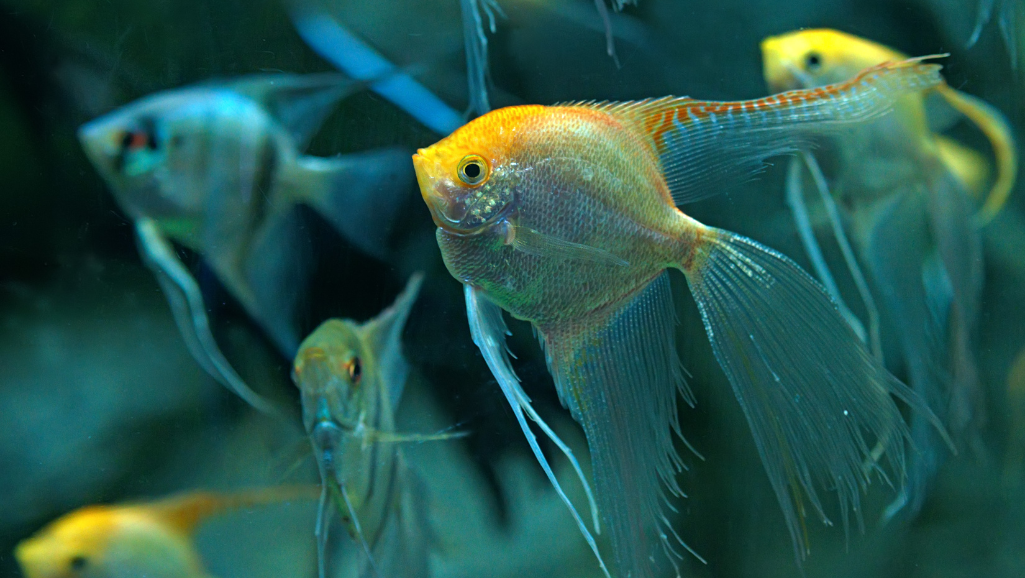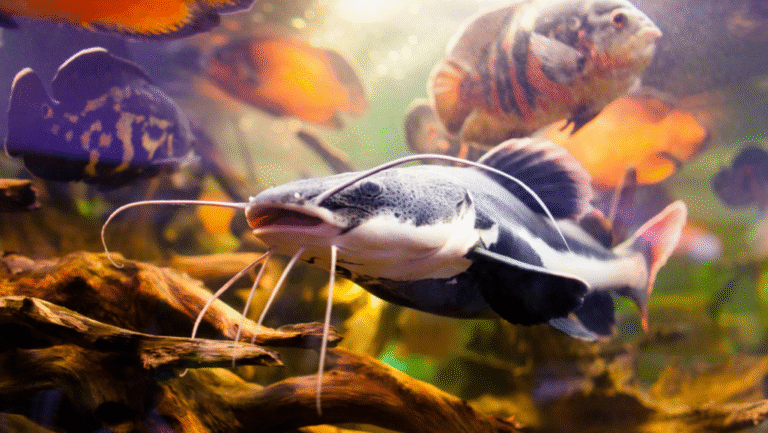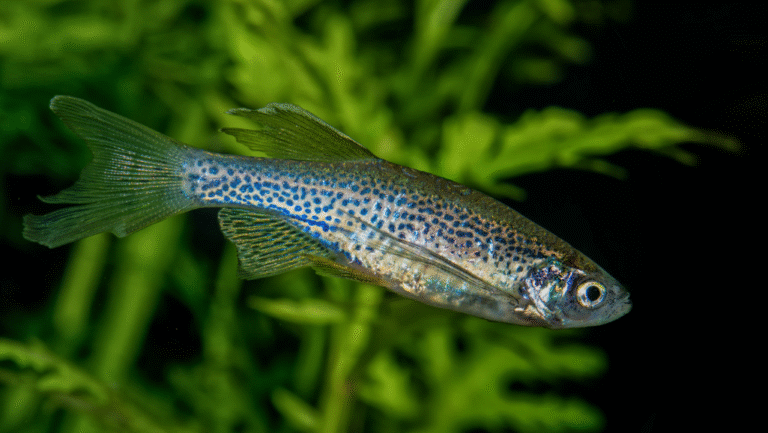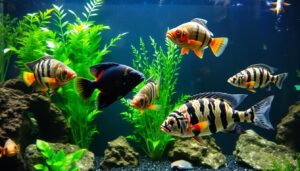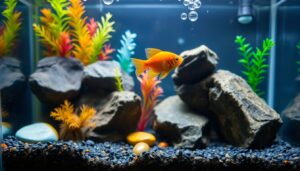Turn your home into a stunning aquatic scene with freshwater angelfish in large tanks. These fish are known for their elegant swimming and unique fins. They need a lot of space to thrive, just like their natural habitat in South America’s rivers.
Without enough room, angelfish can become aggressive. This can upset the peace in your tank. So, creating a big, caring space is key to enjoying these fish as part of your home’s beauty.
Key Takeaways
- Angelfish need lots of space to be healthy and vibrant, just like their natural home.
- Big tanks help prevent fights by giving each fish its own territory, which is good for their health and the tank’s peace.
- Good care for angelfish means keeping the water warm (78-86°F) and the pH right (6.0 to 8.0), just like their tropical home.
- With the right care, angelfish can live up to 12 years, making your aquarium hobby rewarding for a long time.
- Creating a good breeding space with the right water conditions can lead to successful breeding of angelfish.
- Investing in R.O. filters and the right tank sizes improves water quality and care for angelfish, helping your tank run smoothly.
- Learning about angelfish care, including how to keep them with other fish, their diet, and setting up their tank, will make them the stars of your aquarium, creating a peaceful underwater world.
Understanding Angelfish Nature and Behavior
Angelfish are known for their beauty and lively personalities. They are a key part of many aquariums. To keep them happy, it’s important to know about angelfish behavior and how to set up their tank right. Knowing their needs helps reduce freshwater angelfish aggression and keeps the whole tank healthy.
The Unpredictable Aggression in Angelfish
Angelfish may look calm, but they can be quite aggressive. This is often seen when they’re breeding or defending their space. Recognizing stress signs early can help prevent fights and keep the tank peaceful.
Creating a Stimulating Environment for Better Angelfish Health
It’s crucial to make the tank interesting for angelfish. They need varied terrain, places to hide, and different plants. This setup helps them behave naturally and reduces stress. It also keeps them active and happy.
The Importance of Spacious Tanks for Angelfish Cohabitation
Having a big enough tank is key to less freshwater angelfish aggression. Start with at least 58 gallons, more if you plan to keep a community or breed them. This space helps them have their own areas and live better with other fish.
In summary, angelfish can be both calm and aggressive. But with the right care, a big tank, and a good environment, they can thrive. By meeting their needs, we can help these beautiful fish live their best lives in our tanks.
Angelfish Varieties and Their Unique Allure
Exploring the world of angelfish varieties can make your home aquarium more appealing. These fish are known for their grace and bright colors. Varieties like the Marble Angelfish, Koi Angelfish, and Black Lace Angelfish show the beauty of aquatic life.
Each variety brings a special touch to your aquarium. They also show the rich diversity of their South American homes.
- Marble Angelfish: Known for their striking black and white patterns, which mimic the look of marble, making them a standout in any aquarium setting.
- Koi Angelfish: Resembling the ornamental Koi, these fishes are prized for their vibrant orange and white splashes.
- Black Lace Angelfish: Distinguished by their elegant black fins and dark translucent bodies, providing a sophisticated touch to the tank.
- Smokey Angelfish: Feature smokey gray hues that gradient beautifully across their bodies, ideal for a soothing aquarium backdrop.
- Platinum Angelfish: Their shimmering silver-white coloration can brighten any aquarium and attract immediate attention.
These varieties are not just pretty; they’re also easy to care for. They thrive in the right tank conditions and with the right food. This keeps their colors bright and helps them grow well.
These angelfish are beloved in tropical aquariums. Each variety adds something special to their home. Keeping such a diverse group in your home is rewarding and connects you to the natural world.
Learning about different angelfish varieties makes the hobby more rewarding. It also helps keep your aquarium healthy and lively. It shows the beauty and complexity of life under water, inspiring a love for aquatic care and conservation.
Optimal Conditions for Your Angelfish Tank
Creating the optimal environment for angelfish is key to their health and long life. Proper angelfish care starts with the right angelfish water parameters. This is the base of a healthy aquarium.
The Ideal Water Parameters for Angelfish
Angelfish love warm, slightly acidic water, similar to their Amazonian home. Ideal temperatures are between 78-86°F, with a pH of 6.0 to 8.0. Water hardness should be 3-8 degrees dKH. Keeping these parameters in check helps your angelfish stay healthy, avoiding stress and disease.
Following these guidelines is simpler with the right angelfish aquarium setup. This includes good heating and filtration systems. For more on setting up, check out this detailed angelfish care guide.
Adding Plants to an Angelfish Tank: Benefits and Tips
Adding plants like Java Fern does more than make your tank look good. They help control the environment by removing nitrates and providing hiding spots. This reduces stress in fish. Plus, they add to the tank’s ecosystem, making it more natural for your angelfish.
Choosing the Right Tank Size for Angelfish
- Initial Setup: Start with a minimum of 55 gallons for juvenile angelfish, allowing them space to grow and thrive.
- Adult Angelfish Requirements: For adult angelfish, pairs or small groups need a 75-gallon tank or larger, due to their territorial nature.
Good angelfish care means more than just meeting their basic needs. It’s about creating a space that closely mimics their natural habitat. This means careful management of angelfish water parameters, a well-thought-out angelfish aquarium setup, and making adjustments based on your fish’s behavior and health.
Angelfish Diet and Nutrition
Understanding the angelfish diet and nutrition is key to their health and color. A good diet helps them grow and stay vibrant. This makes them a highlight in many aquariums.
When it comes to angelfish feeding, variety and quality are crucial. They need a mix of flake, live, and frozen foods. High-quality dry foods are essential for balanced nutrition. Live foods like brine shrimp or bloodworms boost nutrition and mimic their natural hunting.
- Frozen foods, like bloodworms, are great for breeding angelfish.
- Vegetable-based foods prevent constipation and keep their diet balanced.
- Pellets are easy to feed but should be soaked to ensure they’re hydrated.
For freshwater angelfish nutrition, watch how much and how often you feed them. Overfeeding can harm water quality and their health. Feeding them twice a day, with just enough for a few minutes, keeps the tank clean and healthy.
Understanding angelfish diet and nutrition is more than just feeding them. It’s about knowing their preferences and needs. This ensures they thrive, enhancing your aquarium’s beauty.
A well-fed angelfish is truly stunning, showing off aquatic grace and beauty. So, make sure their diet is diverse and rich, ensuring they live a long and healthy life.
Angelfish Tank Mates and Community Setup
Setting up a peaceful angelfish community aquarium needs careful thought. You must choose tank mates that fit their calm nature and size. This makes their home beautiful and safe.
Compatible Tank Mates for Cohesive Angelfish Community
Choosing the right angelfish compatibility is key. Fish like Corydoras catfish, dwarf gouramis, and tetras are great friends. They don’t bother the angelfish. A good guide on tank mates is here.
Navigating Angelfish Aggression with Suitable Tank Companions
Angelfish are usually calm but can get aggressive when breeding. Introduce tank mates when they’re young. This helps them get used to each other and avoid fights. Make sure the tank is big enough to reduce stress and aggression.
Large fish like rams and loaches, which are the same size as angelfish, help keep the peace.
Avoiding Common Mistakes with Angelfish Pairing
Stay away from guppies and small tetras because angelfish might eat them. Also, avoid very territorial fish that can upset the angelfish during breeding. Learn about each fish’s needs here. This helps pick tank mates that are good for the angelfish and look nice together.
Angelfish Breeding: A Pathway to a Thriving Tank
Starting an angelfish breeding journey can make your aquarium more beautiful. It also lets you see how these amazing fish reproduce. Learning about freshwater angelfish reproduction can make your tank healthier and more lively.
To encourage angelfish spawning, you need to create the right conditions. First, pick a tank that’s big enough. A 20-gallon tank is good for a pair, but a 55-gallon tank or bigger is better for a group. Adding live plants like Amazon Swords and Java Fern makes the tank look great and helps keep it balanced.
- Keeping the water temperature between 78-85ºF is key for spawning.
- Checking the water quality often with Gh/Kh test kits and TDS pens keeps the breeding area healthy.
- Feeding the breeding pair well helps them stay healthy and increases the chance of successful spawning.
When everything is ready, angelfish start to spawn, laying up to 1200 eggs. These eggs are very sensitive to light, so you need to manage the lighting carefully. After they hatch, the fry eat their yolk sacs and then start eating special fry food and baby brine shrimp to grow.
The careful process of angelfish breeding and seeing new fish grow in your tank is very rewarding. It shows how important it is to take good care of your aquarium. Following these tips can help with successful angelfish breeding and keep your tank healthy and beautiful.
Conclusion
The journey into the Angelfish aquarium is a mix of art and science. It turns freshwater angelfish care into a true passion. These graceful swimmers, growing up to 6 inches, add beauty to large tanks.
With the right care, they can reach up to 10 inches. This is in special environments. Their diet of plants and small animals keeps them healthy and colorful.
Their breeding shows the complexity of these fish. It involves a protective display by the parents. To breed them, you need a balanced male-to-female ratio and the right temperature.
Angelfish have been in the hobby since the 1930s. They symbolize elegance and diversity in freshwater tanks. They need at least 20 gallons to swim and thrive.
They are calm but can show territorial behavior. Their care and the advice from discussions on tank mates enhance their legacy. Keeping the tank clean and the water right creates a vibrant underwater world.

